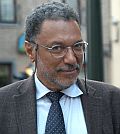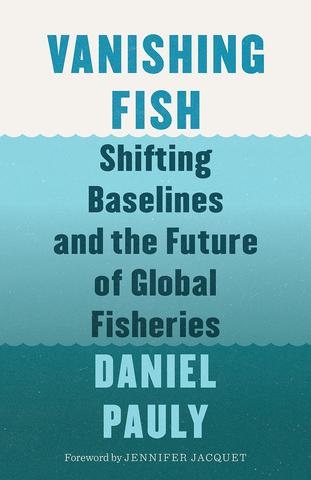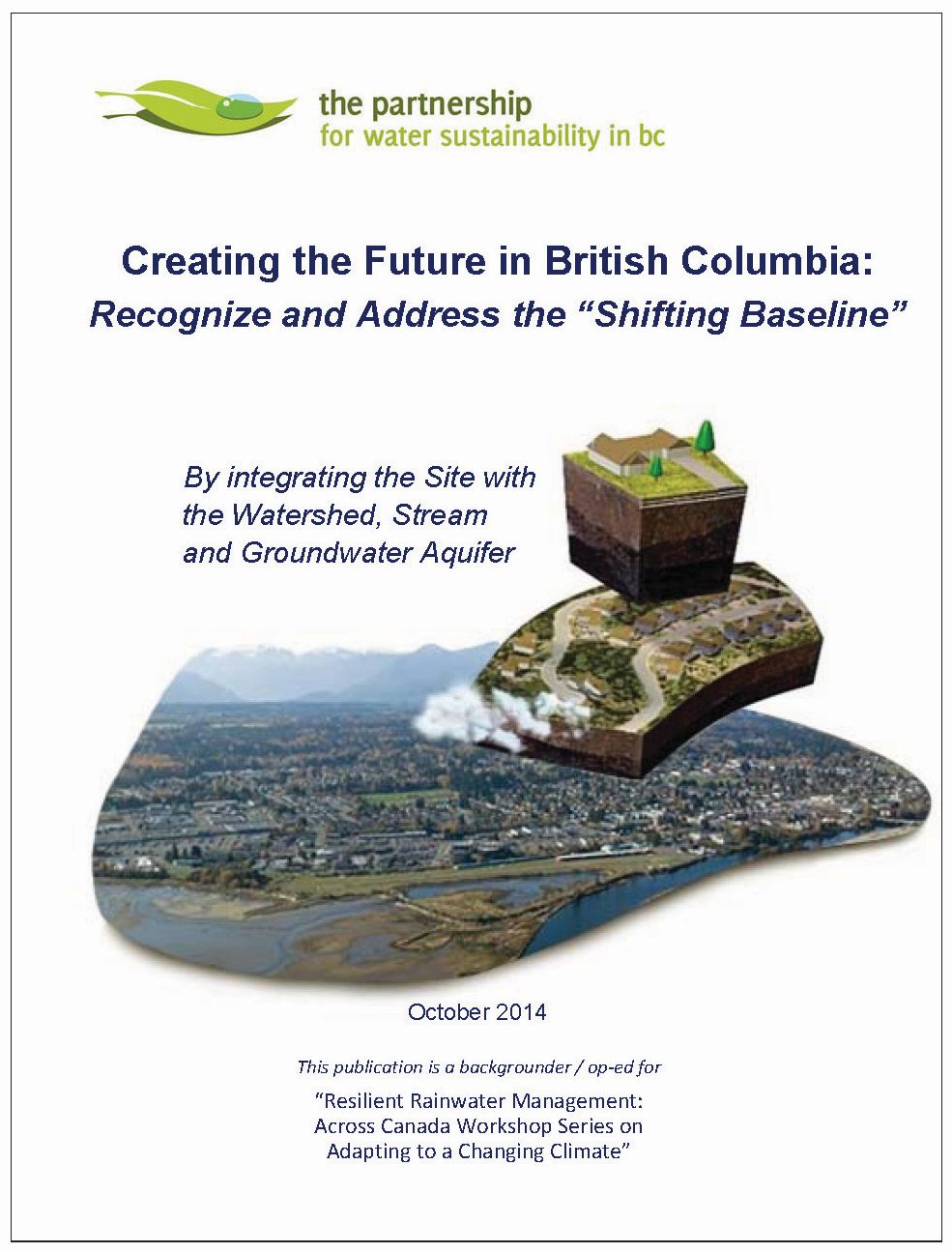SHIFTING BASELINE SYNDROME: “With each new generation, the expectation of various ecological conditions shifts. The result is that standards are lowered almost imperceptibly,” stated Dr. Daniel Pauly, professor and project leader, Sea Around Us Project, Institute for the Oceans and Fisheries at the University of British Columbia
Note to Reader:
Published on Tuesdays, the Partnership for Water Sustainability in BC’s weekly e-Newsletter series features champions who are leading changes in practice in the local government setting that will help achieve this over-reaching vision or goal: IMPROVE WHERE WE LIVE! The story below brought to a close the current season (September 2018 through June 2019) of the series. To access the series, visit Waterbucket News.
WHO READS THE E-NEWSLETTERS? The Partnership’s readership includes most of the Mayors and Councillors in the regions where 85% of the province’s population lives, that is: Vancouver Island, Lower Mainland and Okanagan. As well, our readership extends beyond these regions into other parts of the province. Many in the stewardship sector are also regular readers of these e-Newsletters.
SHOWCASE & CELEBRATE: There is a reason for highlighting that our readership is concentrated in these two sectors. The reason is that a Partnership priority is to showcase and celebrate collaboration between the local government and stewardship sectors. This outcome is being achieved through initiatives such as the Vancouver Island Water Stewardship in a Changing Climate Series.
TOP-DOWN & BOTTOM-UP MODEL: Engagement of community through stewardship is a credible formula to be encouraged and mainstreamed at every opportunity. Collaboration, teamwork and a recognition that the whole is greater than the sum of its parts is the energy that stokes creativity and determination. When citizen talent is aligned with a local government that is both visionary and focused, outstanding achievements are not only possible, but realistic.
IMPROVE WHERE WE LIVE: Over the past season, the Partnership has developed cascading themes: Shrink our destructive footprint while growing our regenerative footprint; Restorative development results in sustainable stream restoration; Get it right by reconnecting hydrology and ecology. Resuming in September, we will build on these ‘big ideas’ to point the way to a desired future.
MISSION POSSIBLE: While communities cannot restore lost diversity, they can halt its decline and consciously direct efforts into bending the trend-line in an upward direction. In this finale issue, we showcase the work of Dr. Daniel Pauly to underscore the theme that we will explore next season: Maybe we are not doomed after all. We have the brains to adapt to climate change, and it starts with restoring the water balance in the built environment. Do we have the will?
IMPROVING WHERE WE LIVE: Maybe we are not doomed after all. We have the brains. Do we have the will?
In 1995, acclaimed marine biologist Daniel Pauly coined the term “shifting baselines” to describe a phenomenon of lowered expectations, in which each generation regards a progressively poorer natural world as normal.
 “The essay on ‘Shifting Baselines’ was written at the request of the Editor of Trends in Ecology and Evolution, who needed a one-page filler for a 1995 issue in order to be able to go to press,” states Daniel Pauly.
“The essay on ‘Shifting Baselines’ was written at the request of the Editor of Trends in Ecology and Evolution, who needed a one-page filler for a 1995 issue in order to be able to go to press,” states Daniel Pauly.
“I wrote it right away, never thinking that it would have the impact that it did have. But this is common in science: authors cannot predict which of their ideas will fly, and which won’t take off. I was lucky that colleagues noticed this essay and tested whether its claim applied.”
 Published in May 2019, Daniel Pauly’s new book is titled Vanishing Fish: Shifting Baselines and the Future of Global Fisheries. “This wonderfully personal and accessible book by the world’s greatest living fisheries biologist summarizes and expands on the causes of collapse and the essential actions that will be required to rebuild fish stocks for future generations,” stated Dr. Jeremy Jackson, ocean scientist and author of Breakpoint, in a testimonial.
Published in May 2019, Daniel Pauly’s new book is titled Vanishing Fish: Shifting Baselines and the Future of Global Fisheries. “This wonderfully personal and accessible book by the world’s greatest living fisheries biologist summarizes and expands on the causes of collapse and the essential actions that will be required to rebuild fish stocks for future generations,” stated Dr. Jeremy Jackson, ocean scientist and author of Breakpoint, in a testimonial.
Environmental Generational Amnesia
Peter Kahn, Professor of Psychology at the University of Washington, equates the Shifting Baseline Syndrome phenomenon to Environmental Generational Amnesia. Peter Kahn calls our environmental generational amnesia “one of the central psychological problems of our lifetime,” because it obscures the magnitude of so many concrete problems.
 “People take the natural environment they encounter during childhood as the norm against which they measure environmental degradation later in their life. Each generation takes that degraded condition as the non-degraded condition, as the normal experience,” explains Peter Kahn.
“People take the natural environment they encounter during childhood as the norm against which they measure environmental degradation later in their life. Each generation takes that degraded condition as the non-degraded condition, as the normal experience,” explains Peter Kahn.
“Since the problem of environmental generation amnesia has its genesis in childhood, I suggest that childhood is a good place to start solving the problem.”

The Shifting Baseline Syndrome is….
Shifting Baseline Syndrome refers to a gradual change in the accepted norm for ecological conditions.
The phrase describes an incremental eroding of standards that results with each new generation lacking knowledge of the historical, and presumably more natural, condition of the environment. Each generation then defines what is ‘natural’ or ‘normal’ according to current conditions and personal experiences.
With each new generation, the expectations of various ecological conditions shifts. Over time, and in the absence of a ‘teachable moment’ to raise awareness of a change, the result is that standards are lowered almost imperceptibly.
A Short History
The concept arose in Ian McHarg’s seminal book Design with Nature, published in 1969. Renowned as a landscape architect, writer and educator, Ian McHarg (1920-2001) is best known for introducing environmental concerns in landscape architecture. McHarg compared the landscape as we know it to that which ancient humans lived on.
“The innovation of which I am most proud was the discovery that the competing claims of the many environmental scientists could be organized through the employment of chronology. Investigation began with the oldest evidence and proceeded towards the present,” wrote Ian McHarg in the Preface to the 1992 edition of Design with Nature.
Daniel Pauly developed the concept in reference to fisheries management in a one-page paper titled Anecdotes and the shifting baseline syndrome of fisheries.
“It’s one of my most cited papers, though it’s a very short piece. It’s like a thinking piece; it has no numbers, no equations. This piece became the topic of a blog that ran for several years by a Hollywood filmmaker. It became a stock phrase,” explains Daniel Pauly.
In 2002, film-maker and former marine biologist Randy Olson broadened the definition with an op-ed in the Los Angeles Times newspaper. He explained the relevance of the concept to all aspects of change and the failure to notice change in the world today.
“If we know the baseline for a degraded ecosystem, we can work to restore it. But if the baseline shifted before we really had a chance to chart it, then we can end up accepting a degraded state as normal — or even as an improvement,” wrote Randy Olson.
“And the question is, why do people accept this,” stated Daniel Pauly during his TED Talk in 2010
“We transform the world, but we don’t remember it. We adjust our baseline to the new level, and we don’t recall what was there. If you generalize this, something like this happens (refer to graphic ABOVE),” explains Daniel Pauly.
“You have on the y axis some good thing: biodiversity, numbers of orca, the greenness of your country, the water supply. And over time it changes – it changes because people do things, or naturally.
“Every generation will use the images that they got at the beginning of their conscious lives as a standard and will extrapolate forward. And the difference then, they perceive as a loss. But they don’t perceive what happened before as a loss.
“You can have a succession of changes. At the end you want to sustain miserable leftovers. And that, to a large extent, is what we want to do now. We want to sustain things that are gone or things that are not the way they were.
“And the question is, why do people accept this? Well because they don’t know that it was different. And in fact, lots of people, scientists, will contest that it was really different. And they will contest this because the evidence presented in an earlier mode is not in the way they would like the evidence presented.
“So you have a situation where people don’t know the past, even though we live in literate societies, because they don’t trust the sources of the past,” concludes Daniel Pauly.
In 2014, the Partnership for Water Sustainability prepared a backgrounder to help inform knowledge-sharing via an Across Canada Workshop Series
An understanding of Daniel Pauly’s “Shifting Baseline Syndrome” is a foundation piece for implementing restorative development, reconnecting hydrology and ecology, and bending the curve to restore stream systems.
Accepted ‘standards of practice’ – especially those for engineering, planning and finance – influence the form and function of the Built Environment. The goal of shifting to an ecologically functioning and resilient baseline and creating a creekshed legacy will ultimately depend on the nature of change to standards of practice.
To Learn More:
To download a PDF copy, click on Creating the Future in British Columbia: Recognize and Address the “Shifting Baseline”.


